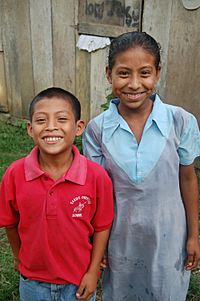Qʼeqchiʼ facts for kids
|
Q'eqchi' Maya children, Belize
|
|
| Total population | |
|---|---|
| 1,370,007 | |
| Regions with significant populations | |
| 1,370,007 | |
| 11,143 | |
| 834 | |
| 245 | |
| ? | |
| Languages | |
| Qʼeqchiʼ, Spanish, Kriol, English | |
| Religion | |
| Roman Catholic, Evangelical, Mennonite, Maya religion, recent small communities of Eastern Orthodox and Oriental Orthodox in West Guatemala. | |
The Qʼeqchiʼ (say it: Kek-chee) are a group of Maya people. They mostly live in Guatemala and Belize. They speak their own language, called Qʼeqchiʼ.
Hundreds of years ago, before the Spanish arrived in the 1520s, the Qʼeqchiʼ lived in areas now called Alta Verapaz and Baja Verapaz in Guatemala. Over time, because of land changes and moves, Qʼeqchiʼ communities spread out. You can now find them in other parts of Guatemala like Izabal and Petén. They also live in southern Belize, and smaller groups are in southern Mexico. Today, Qʼeqchiʼ speakers are found in more places across Guatemala than any other Maya group.
Contents
What is the History of the Qʼeqchiʼ People?
We don't know much about the Qʼeqchiʼ people before the Spanish arrived. We do know they were a Maya group living in the highlands and lowlands of Guatemala. Their land was known as Tezulutlan, meaning "land of war." The Qʼeqchiʼ had their own king, laws, and government.
When the Spanish tried to conquer them, the Qʼeqchiʼ were hard to control. This was because their people were spread out. A Spanish priest named Bartolomé de las Casas tried to convert them to Christianity. Only a small number became Christian, and the church lost control over them. This led to plantation owners and slavers taking advantage of the Qʼeqchiʼ people.
How Did Plantations Change Qʼeqchiʼ Life?
In the 1800s, large farms called plantations became very important to the Qʼeqchiʼ. Plantation owners took over the Qʼeqchiʼ's shared land. The Qʼeqchiʼ people then had to work on these plantations. By 1877, the government ended all shared land ownership. This caused some Qʼeqchiʼ to move to Belize. Losing their land, along with the effects of the Spanish conquest, led to long-lasting poverty for the Qʼeqchiʼ people.
What are Qʼeqchiʼ Beliefs and Traditions?
Religion
Traditionally, the Qʼeqchiʼ believe in the Tzuultaqʼaʼ. These are spirits or gods of the mountains and valleys. Over time, they have blended these beliefs with those of the Catholic Church. Some Qʼeqchiʼ believe in the Christian God and honor Catholic saints. They also believe that Tzuultaqʼaʼ watches over nature and lives in mountain caves.
The Qʼeqchiʼ have special religious leaders from their traditional beliefs:
- Ilonel: These are healers who use herbs and ceremonies.
- Aj ke: These are seers who give advice and predict things for the village.
- Aj tul: These are believed to be sorcerers who can cast spells.
The Qʼeqchiʼ also celebrate rituals similar to those in other Latin American countries, like the Day of the Dead. They have a special ritual for the dead. They wrap the body in a straw mat called a petite. Then, they bury the person with items they might need for their journey into the afterlife.
Marriage
Marriage in Qʼeqchiʼ culture is often arranged by the parents. The parents of the boy and girl meet over time. If everything goes well, the children get married. Girls usually marry between 12 and 15 years old, and boys between 15 and 18. After marriage, a family looks like a typical family: a mother, a father, and children. When it comes to passing down property, parents usually give their land and belongings to the child who promises to care for them in their old age.
What Do Qʼeqchiʼ People Eat and Grow?
The Qʼeqchiʼ people mainly practice subsistence farming. This means they grow food only for their families, not to sell. In the past, the Qʼeqchiʼ grew many different plants. These included edible weeds, banana plants, and other crops that grew well together. They also found some food from wild plants, and some villages still hunt.
However, for most Qʼeqchiʼ people today, their main food comes from corn fields. This change happened when plantations became powerful. From the 1880s to the 1940s, plantation owners only allowed Qʼeqchiʼ people to grow corn and beans. This made it easy for the owners to know which crops were theirs. This rule made the Qʼeqchiʼ diet very dependent on corn.
Even though corn doesn't bring much money or provide a full diet, it has other meanings. The Qʼeqchiʼ use farming to connect with God in a very real and spiritual way. Planting new life in the soil makes them feel like they are helping create things. All parts of farming—planting, growing, and harvesting—are seen as rituals and worship in their religion.
What are Current Issues for the Qʼeqchiʼ?
The QHA, or Qʼeqchiʼ Healers Association, is a group of traditional healers. They work together to share ways of protecting nature and learning about plants. The QHA, along with the Belize Indigenous Training Institute, helped create a traditional healing garden and culture center. Here, Qʼeqchiʼ healers share their methods that have been passed down through generations. They hope to save rare plants and teach their community. They are protecting the variety of life in their region by finding new ways to grow and care for rare plant species, instead of just gathering them from the wild.
Who are Some Famous Qʼeqchiʼ People?
- Cristina Coc: She led 39 villages in Belize to win important rights to their traditional lands. She also received the Equator Prize.
- Rodrigo Tot: He was awarded the Goldman Environment Prize in 2017 for his work.
- Oscar Santis
Images for kids
See also
 In Spanish: Kekchí (etnia) para niños
In Spanish: Kekchí (etnia) para niños



